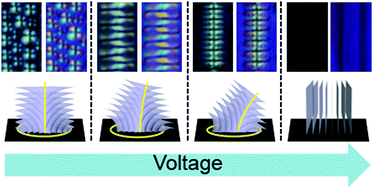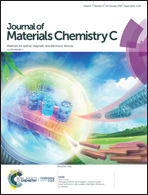Controllable liquid crystal defect arrays induced by an in-plane electric field and their lithographic applications†
Abstract
We control the shape and arrangement of various kinds of liquid crystal (LC) defects in nematic (N) and smectic A (SmA) phases using an in-plane electric field. Periodic zigzag disclination line defects generated in the N phase with a winding number of −1/2 are transformed to arrays of focal conic domains (FCDs) in the SmA phase upon cooling under the electric field. Notably, reconfigurable arrays of FCDs such as hexagonal, alternating, and face-to-face arrangements are generated by varying the applied voltage, and are analyzed using polarized optical microscopy (POM) and fluorescence confocal polarized microscopy (FCPM). For the molecular scale analysis, in situ grazing incidence X-ray diffraction (GIXD) experiments are carried out to determine the internal layer and molecular configurations. To demonstrate the versatility of our platform, defect arrays produced in the SmA phase are used as lithographic templates to generate distinct quantum dot (QD) arrays. Our approach can provide reconfigurable lithographic templates for functional materials.



 Please wait while we load your content...
Please wait while we load your content...